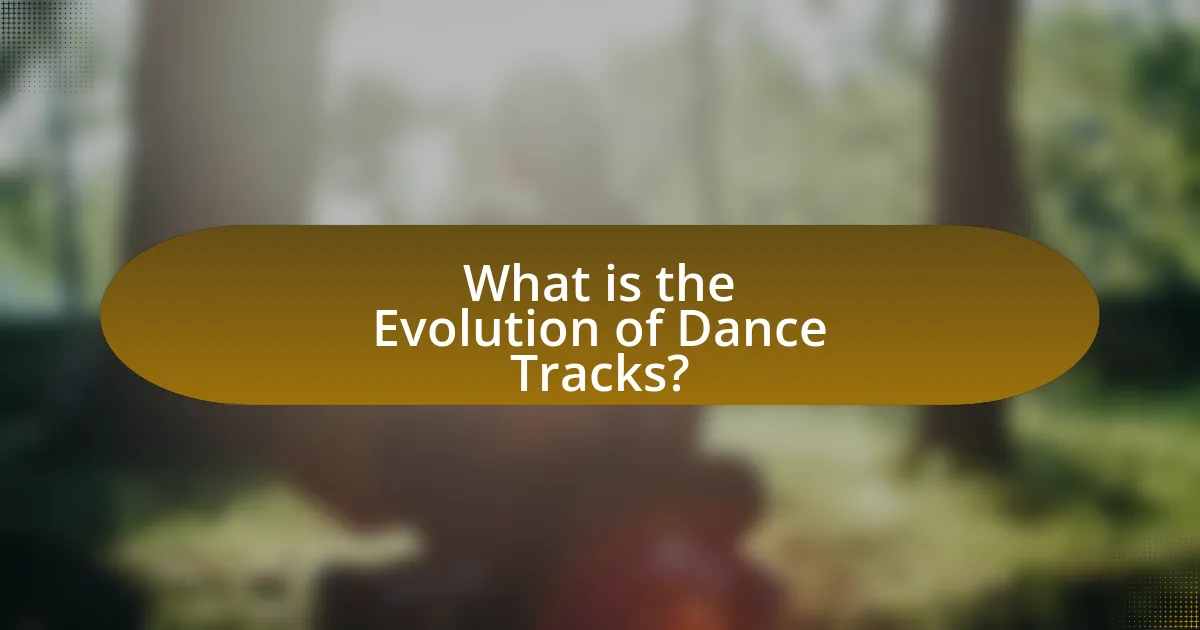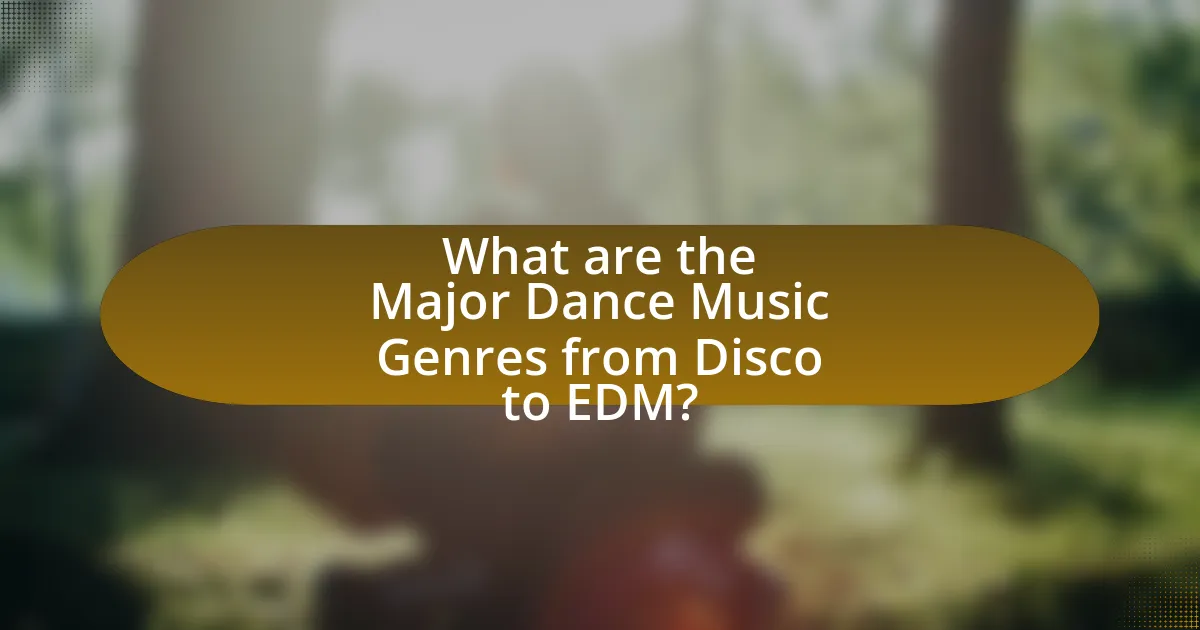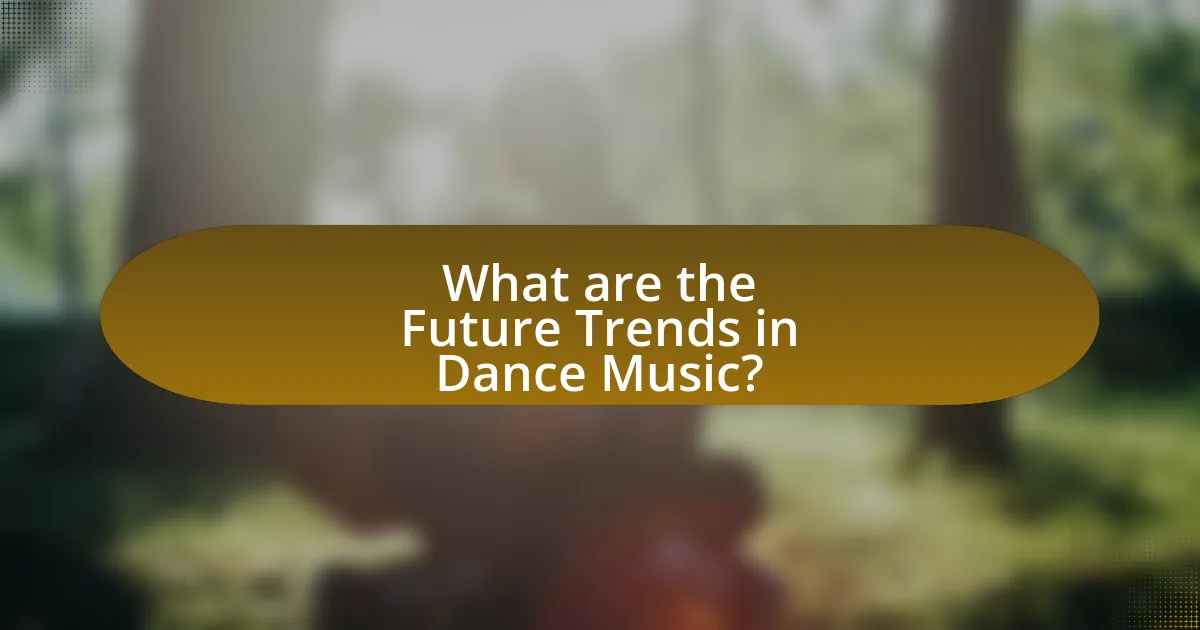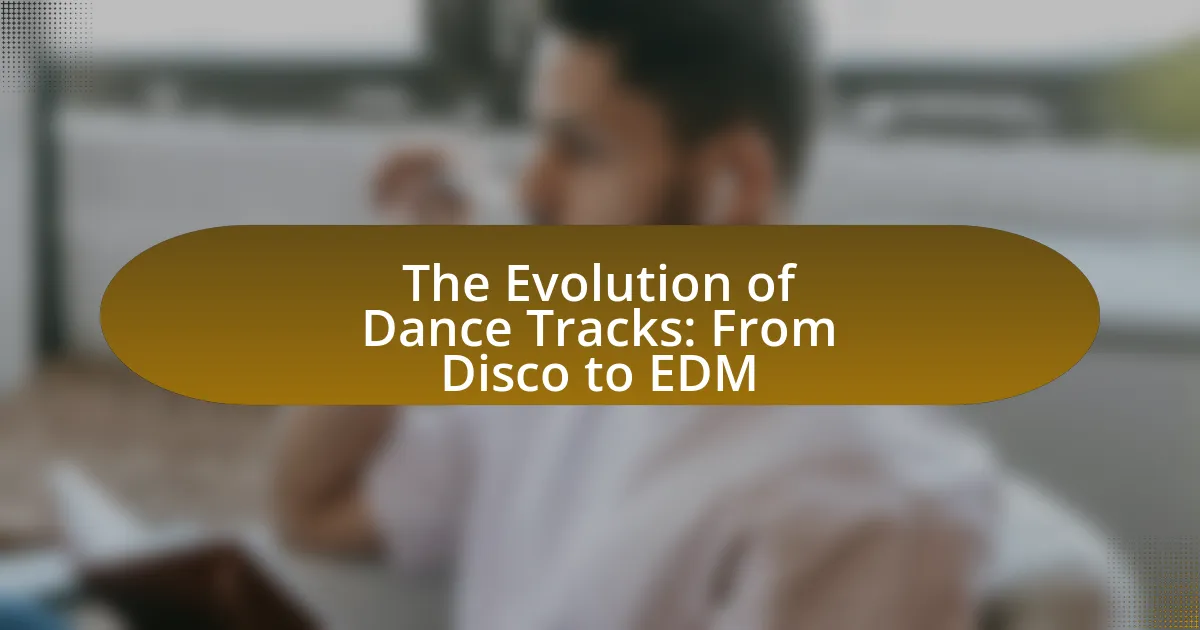The article examines the evolution of dance tracks from their origins in disco during the 1970s to the contemporary landscape of electronic dance music (EDM). It outlines the key characteristics of disco, house, techno, and other genres, highlighting the technological advancements and cultural influences that shaped their development. The discussion includes the impact of synthesizers, digital production, and social movements on dance music, as well as the role of DJs and the significance of nightlife culture. Additionally, the article explores future trends in dance music, including hybrid genres, the use of artificial intelligence in production, and a growing emphasis on sustainability within the industry.

What is the Evolution of Dance Tracks?
The evolution of dance tracks spans several decades, beginning with disco in the 1970s and transitioning through various genres to contemporary electronic dance music (EDM). Disco emerged as a dominant genre characterized by its four-on-the-floor beats and orchestral arrangements, influencing early dance music. In the 1980s, the introduction of synthesizers and drum machines led to the rise of house music, which incorporated elements of disco while adding a more electronic sound.
The 1990s saw the emergence of techno and trance, genres that further pushed the boundaries of electronic music, with artists like Derrick May and Paul van Dyk gaining prominence. By the 2000s, the popularity of EDM surged, driven by advancements in music production technology and the rise of festivals, with artists like David Guetta and Calvin Harris leading the charge.
Today, dance tracks continue to evolve, incorporating diverse influences from hip-hop, pop, and global music styles, reflecting the dynamic nature of the genre. This historical progression illustrates how dance music has transformed from its disco roots to a multifaceted global phenomenon.
How did dance music genres emerge over time?
Dance music genres emerged over time through a series of cultural and technological developments that shaped their evolution. Initially, in the 1970s, disco music became popular, characterized by its four-on-the-floor beat and orchestral arrangements, which laid the groundwork for future dance genres. The advent of synthesizers and drum machines in the 1980s led to the rise of electronic dance music (EDM) genres such as house and techno, which emphasized rhythm and electronic sounds.
In the 1990s, the globalization of music and the internet facilitated the spread of various subgenres, including trance, drum and bass, and garage, each incorporating unique elements from different cultures and musical styles. By the 2000s, EDM gained mainstream popularity, with festivals and clubs showcasing a wide range of styles, including dubstep and progressive house. This evolution reflects the continuous interplay between technological advancements, cultural influences, and audience preferences, resulting in a diverse landscape of dance music genres today.
What are the key characteristics of Disco music?
Disco music is characterized by its four-on-the-floor beat, syncopated basslines, and orchestral arrangements, which create a danceable rhythm. The genre emerged in the 1970s, primarily in urban nightlife scenes, and is known for its use of electronic instruments, such as synthesizers and drum machines, alongside traditional instruments like guitars and horns. Disco tracks often feature repetitive lyrics and catchy melodies, designed to engage listeners on the dance floor. The genre’s influence is evident in its cultural impact, including the rise of disco clubs and the popularity of artists like Donna Summer and the Bee Gees, who contributed to its mainstream success.
How did Disco influence later dance music genres?
Disco significantly influenced later dance music genres by establishing foundational elements such as four-on-the-floor beats, syncopated basslines, and orchestral arrangements. These characteristics became integral to genres like house, techno, and pop music in the 1980s and beyond. For instance, house music, which emerged in Chicago in the early 1980s, directly drew from disco’s rhythmic structure and vocal styles, as evidenced by tracks like “Your Love” by Frankie Knuckles. Additionally, the use of synthesizers and drum machines in disco paved the way for electronic dance music (EDM), which relies heavily on these technologies. The cultural impact of disco also fostered a vibrant club scene that encouraged the evolution of DJing and remixing practices, further shaping the landscape of modern dance music.
What role did technology play in the evolution of dance tracks?
Technology has been pivotal in the evolution of dance tracks, enabling new sounds, production techniques, and accessibility. The introduction of synthesizers in the late 1970s allowed artists to create unique electronic sounds that defined genres like disco and later house music. The development of digital audio workstations (DAWs) in the 1990s revolutionized music production, allowing for intricate layering and editing of tracks, which became essential in the creation of EDM. Additionally, advancements in sampling technology facilitated the incorporation of diverse musical elements, broadening the creative possibilities for producers. The rise of the internet and digital distribution platforms further democratized music production, allowing independent artists to share their dance tracks globally, thus accelerating the genre’s evolution.
How did the introduction of synthesizers change dance music?
The introduction of synthesizers revolutionized dance music by enabling the creation of new sounds and textures that were previously unattainable with traditional instruments. Synthesizers allowed producers to manipulate sound waves, leading to the development of genres such as techno and house in the 1980s, which relied heavily on synthesized sounds. The iconic Roland TR-808 drum machine and the Yamaha DX7 synthesizer became staples in dance music production, providing distinctive beats and melodies that defined the era. This technological advancement not only expanded the sonic palette available to artists but also facilitated the rise of electronic dance music (EDM) as a dominant genre in the music industry.
What impact did digital production have on dance tracks?
Digital production revolutionized dance tracks by enabling greater accessibility, creativity, and precision in music creation. This technological advancement allowed producers to utilize software and digital tools to manipulate sounds, create complex arrangements, and experiment with various genres, leading to the emergence of electronic dance music (EDM) as a dominant force in the music industry. For instance, the introduction of digital audio workstations (DAWs) like Ableton Live and FL Studio facilitated the production of intricate beats and layers that were previously difficult to achieve in traditional studio settings. Additionally, the ability to easily share and distribute music online has democratized the production process, allowing independent artists to reach global audiences without the need for major label support.
Why is the cultural context important in the evolution of dance music?
Cultural context is crucial in the evolution of dance music because it shapes the genre’s themes, styles, and audience reception. For instance, the disco era of the 1970s emerged from urban nightlife and LGBTQ+ communities, reflecting social movements and cultural liberation, which influenced its sound and popularity. Similarly, the rise of electronic dance music (EDM) in the 2000s was driven by technological advancements and the globalization of music, allowing diverse cultural influences to merge, as seen in the incorporation of elements from house, techno, and hip-hop. This interplay between cultural context and musical evolution demonstrates how societal factors, such as politics, technology, and community identity, directly impact the development and transformation of dance music genres.
How did social movements influence the development of dance genres?
Social movements significantly influenced the development of dance genres by shaping cultural expressions and promoting social change through music and dance. For instance, the civil rights movement in the 1960s led to the emergence of funk and disco, genres that celebrated African American culture and provided a platform for social commentary. Additionally, the LGBTQ+ rights movement in the 1970s and 1980s played a crucial role in the rise of disco and house music, as these genres became synonymous with LGBTQ+ nightlife and community identity. The Stonewall Riots of 1969, a pivotal event in LGBTQ+ history, catalyzed the popularity of dance music in clubs, fostering an inclusive environment that encouraged self-expression and freedom. Thus, social movements not only influenced the themes and styles of dance genres but also facilitated their growth and acceptance in mainstream culture.
What are the connections between dance music and nightlife culture?
Dance music is intrinsically linked to nightlife culture as it serves as the primary soundtrack for social gatherings in clubs and festivals. This connection is rooted in the historical evolution of dance music, beginning with disco in the 1970s, which transformed nightlife into a vibrant social experience characterized by dancing and communal enjoyment. The rise of electronic dance music (EDM) in the late 20th century further solidified this relationship, as DJs became central figures in nightlife, creating immersive environments that encourage prolonged dancing and social interaction. Studies show that nightlife venues often curate their atmospheres around specific dance music genres, enhancing the overall experience and fostering a sense of community among attendees.

What are the Major Dance Music Genres from Disco to EDM?
The major dance music genres from Disco to EDM include Disco, House, Techno, Trance, Drum and Bass, Dubstep, and EDM itself. Disco emerged in the 1970s, characterized by its four-on-the-floor beat and orchestral arrangements, influencing the development of House music in the 1980s, which introduced synthesizers and a more electronic sound. Techno, also originating in the 1980s, focused on repetitive beats and futuristic themes. Trance, known for its melodic and emotional elements, gained popularity in the 1990s. Drum and Bass, with its fast breakbeats and heavy basslines, emerged in the early 1990s. Dubstep, characterized by its wobbly bass and syncopated rhythms, rose to prominence in the late 2000s. Finally, EDM, a broad term encompassing various electronic dance music styles, became mainstream in the 2010s, featuring high-energy drops and festival culture. Each genre has distinct characteristics and historical significance, contributing to the evolution of dance music.
What defines the transition from Disco to House music?
The transition from Disco to House music is defined by a shift in musical structure, production techniques, and cultural context. Disco, characterized by its orchestral arrangements and four-on-the-floor beats, evolved into House music, which emphasized electronic instrumentation, repetitive beats, and a more minimalistic approach. This change was influenced by the advent of affordable synthesizers and drum machines in the early 1980s, allowing producers to create tracks that were more accessible and suited for underground dance clubs. The Chicago House scene, led by figures like Frankie Knuckles, played a pivotal role in this transition, as it embraced a rawer sound that focused on rhythm and groove rather than the lush arrangements typical of Disco.
How did House music evolve from its Disco roots?
House music evolved from its Disco roots by incorporating electronic instruments and a more repetitive, minimalistic structure. In the early 1980s, DJs in Chicago began to experiment with drum machines and synthesizers, creating a sound that retained the danceable beats of Disco while introducing new elements like 4/4 kick drums and synthesized basslines. This shift was influenced by the decline of Disco’s popularity and the rise of underground club culture, where DJs sought to create a continuous flow of music for dancing. The use of samples from Disco tracks also helped bridge the gap, allowing House music to pay homage to its predecessor while establishing its own identity.
What are the key features of House music?
House music is characterized by its repetitive 4/4 beat, synthesized basslines, and use of samples from disco and funk tracks. The genre typically features a tempo ranging from 120 to 130 beats per minute, creating a danceable rhythm. Additionally, house music often incorporates vocal elements, either through samples or original lyrics, which contribute to its emotive quality. The use of electronic instruments and production techniques, such as drum machines and synthesizers, further defines the sound of house music. Historically, house music emerged in the early 1980s in Chicago, with influential figures like Frankie Knuckles and Larry Heard shaping its development, solidifying its place in the evolution of dance music.
How did Techno emerge as a distinct genre?
Techno emerged as a distinct genre in the mid-1980s, primarily in Detroit, Michigan, characterized by its repetitive beats and synthesized sounds. The genre was influenced by electronic music pioneers such as Kraftwerk and the Chicago house scene, which emphasized rhythm and technology. Key figures like Juan Atkins, Derrick May, and Kevin Saunderson, often referred to as the “Belleville Three,” played crucial roles in developing techno’s unique sound by blending elements of funk, disco, and electronic music. The establishment of underground clubs and raves in Detroit further solidified techno’s identity, allowing it to gain popularity and evolve into a global phenomenon.
What are the defining elements of Techno music?
The defining elements of Techno music include a repetitive four-on-the-floor beat, synthesized sounds, and a focus on rhythm and texture over melody. Techno typically features a tempo ranging from 120 to 150 beats per minute, creating a driving energy that is characteristic of the genre. The use of electronic instruments, such as drum machines and synthesizers, is fundamental, allowing for the creation of unique soundscapes. Additionally, Techno often incorporates minimalistic structures, emphasizing gradual changes and layering of sounds, which enhances the immersive experience for listeners. These elements collectively contribute to Techno’s identity as a genre that prioritizes the dance experience and the exploration of sound.
How did Techno influence the development of EDM?
Techno significantly influenced the development of EDM by establishing foundational elements such as repetitive beats, synthesized sounds, and a focus on rhythm over melody. Originating in Detroit during the 1980s, techno introduced a new approach to music production that emphasized electronic instrumentation and innovative sound design. This genre’s emphasis on technology and experimentation paved the way for various EDM subgenres, including house, trance, and dubstep, which adopted and adapted techno’s core characteristics. The rise of techno clubs and raves in the 1990s further popularized electronic music, leading to the mainstream acceptance of EDM as a dominant genre in global music culture.
What are the characteristics of EDM compared to earlier genres?
EDM, or Electronic Dance Music, is characterized by its heavy use of synthesizers, digital production techniques, and a focus on rhythm and beat, distinguishing it from earlier genres like disco and funk. Unlike disco, which relied on live instrumentation and vocal performances, EDM primarily utilizes computer-generated sounds and samples, allowing for a broader range of sonic experimentation. Additionally, EDM often features a faster tempo, typically ranging from 120 to 150 beats per minute, compared to disco’s more moderate pace of around 110 to 130 beats per minute. The structure of EDM tracks frequently includes build-ups and drops, creating dynamic shifts that engage listeners, a technique less prevalent in earlier genres. Furthermore, EDM has a global appeal, with subgenres like house, techno, and dubstep, each incorporating unique elements while maintaining the core electronic foundation. This evolution reflects a shift in music production and consumption, with festivals and DJ performances becoming central to the EDM experience, contrasting with the club-centric nature of disco.
How has EDM changed the landscape of dance music festivals?
EDM has transformed the landscape of dance music festivals by significantly increasing their scale, popularity, and production value. Festivals like Tomorrowland and Ultra Music Festival have grown to attract hundreds of thousands of attendees, showcasing elaborate stages, light shows, and immersive experiences that were not as prevalent in earlier dance music festivals. The rise of EDM has also led to a diversification of genres within festivals, incorporating various sub-genres like house, techno, and dubstep, thus appealing to a broader audience. According to a 2019 report by the International Music Summit, the global electronic music market was valued at $7.3 billion, highlighting the economic impact and cultural significance of EDM in the festival scene.
What role do DJs play in the EDM scene?
DJs play a crucial role in the EDM scene by curating and mixing tracks to create a seamless musical experience for audiences. They are responsible for selecting songs that resonate with the crowd, maintaining energy levels, and often incorporating live remixing techniques to enhance performances. This role has evolved from the early days of disco, where DJs primarily played records, to the modern EDM landscape, where they utilize advanced technology and software to manipulate sound in real-time. The impact of DJs is evident in the growth of festivals and events, with major DJs like Tiësto and Calvin Harris drawing massive crowds and significantly influencing the genre’s popularity and evolution.

What are the Future Trends in Dance Music?
The future trends in dance music include the rise of hybrid genres, increased use of artificial intelligence in music production, and a focus on sustainability in events. Hybrid genres, such as combining elements of techno with pop or hip-hop, are gaining popularity as artists seek to innovate and reach broader audiences. The integration of artificial intelligence is transforming music creation, with AI tools assisting in composition and sound design, allowing for unique and complex productions. Additionally, the dance music industry is increasingly prioritizing sustainability, with festivals and events adopting eco-friendly practices to reduce their environmental impact, reflecting a growing awareness among artists and fans alike. These trends are supported by industry reports indicating a shift towards more diverse musical styles and a commitment to environmental responsibility within the music community.
How is technology shaping the future of dance tracks?
Technology is shaping the future of dance tracks by enabling innovative production techniques and enhancing accessibility for artists. Digital audio workstations (DAWs) allow producers to create complex compositions with ease, while software synthesizers and plugins expand sound design possibilities. Additionally, advancements in artificial intelligence are facilitating music creation, with AI tools capable of generating melodies and beats, thus streamlining the creative process. The rise of streaming platforms has also transformed distribution, allowing artists to reach global audiences instantly, which has led to a more diverse range of influences in dance music. According to a report by the International Federation of the Phonographic Industry, streaming accounted for 62.1% of global recorded music revenue in 2020, highlighting its impact on the music industry, including dance tracks.
What innovations are emerging in music production for dance tracks?
Innovations in music production for dance tracks include the use of artificial intelligence (AI) for composition and sound design, advanced digital audio workstations (DAWs) with enhanced features, and the integration of immersive audio technologies like spatial audio. AI tools, such as OpenAI’s MuseNet, enable producers to generate melodies and harmonies, streamlining the creative process. Modern DAWs, like Ableton Live and FL Studio, offer real-time collaboration and cloud-based features, allowing artists to work together seamlessly from different locations. Additionally, spatial audio technologies, such as Dolby Atmos, provide a more immersive listening experience, enhancing the emotional impact of dance tracks. These innovations reflect the ongoing evolution of music production techniques, catering to the demands of contemporary audiences and the dynamic nature of the dance music genre.
How are streaming platforms influencing dance music consumption?
Streaming platforms are significantly influencing dance music consumption by providing easy access to a vast library of tracks and personalized playlists. This accessibility allows listeners to discover new artists and genres, leading to increased exposure and popularity of dance music. According to a report by the International Federation of the Phonographic Industry (IFPI), streaming accounted for 62.1% of global recorded music revenue in 2020, highlighting its dominance in music consumption. Additionally, platforms like Spotify and Apple Music utilize algorithms to curate personalized recommendations, which further enhances user engagement with dance music. This shift in consumption patterns has transformed how artists promote their work, often prioritizing streaming-friendly releases to reach wider audiences.
What are the potential directions for dance music genres?
Dance music genres are likely to evolve towards greater integration of technology, cross-genre experimentation, and a focus on sustainability. The rise of artificial intelligence in music production is enabling artists to create innovative sounds and compositions, as seen in the increasing use of AI-generated tracks in mainstream dance music. Additionally, collaborations between genres, such as the fusion of electronic music with hip-hop or pop, are becoming more prevalent, reflecting a trend towards genre-blending that appeals to diverse audiences. Furthermore, the dance music scene is increasingly prioritizing eco-friendly practices, with festivals and events adopting sustainable measures, which aligns with a growing global emphasis on environmental responsibility. These directions indicate a dynamic future for dance music, shaped by technological advancements, artistic collaboration, and social consciousness.
How might cultural shifts impact the evolution of dance music?
Cultural shifts significantly impact the evolution of dance music by influencing its styles, themes, and production techniques. For instance, the rise of hip-hop culture in the 1980s led to the incorporation of rap elements into dance tracks, resulting in genres like house and techno that blended rhythmic beats with vocal performances. Additionally, the LGBTQ+ rights movement has historically shaped dance music scenes, particularly in the development of disco in the 1970s, which celebrated diversity and inclusivity. The globalization of music through the internet has also allowed for cross-cultural collaborations, leading to the emergence of subgenres like reggaeton and K-pop-infused dance tracks. These cultural dynamics demonstrate how societal changes directly inform the sounds and structures of dance music, reflecting the values and experiences of different communities.
What new genres or sub-genres are emerging in the dance music scene?
New genres and sub-genres emerging in the dance music scene include lo-fi house, future garage, and tech house. Lo-fi house blends house music with ambient sounds and vintage samples, creating a nostalgic yet modern vibe. Future garage incorporates elements of UK garage and dubstep, characterized by its atmospheric soundscapes and intricate rhythms. Tech house combines techno and house, focusing on minimalistic beats and deep basslines. These genres reflect the ongoing innovation within the dance music landscape, driven by evolving technology and cultural influences.
What practical tips can aspiring producers follow in the dance music industry?
Aspiring producers in the dance music industry should focus on developing their unique sound, mastering production software, and networking effectively. Establishing a distinct musical identity helps producers stand out in a competitive market, as evidenced by successful artists like Calvin Harris and Deadmau5, who have cultivated recognizable styles. Proficiency in digital audio workstations (DAWs) such as Ableton Live or FL Studio is essential, as these tools are industry standards for creating high-quality tracks. Additionally, networking with other artists, attending industry events, and engaging on social media platforms can lead to collaborations and opportunities, as seen in the rise of many producers who leveraged online communities to gain exposure.
